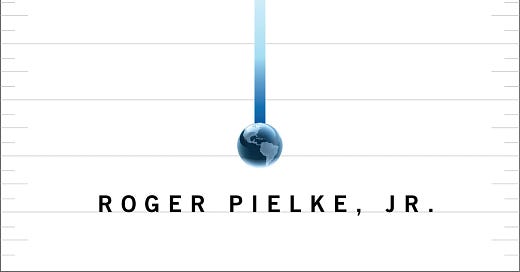The Climate Fix Book Club, Chapter 6
How Climate Policy Went Off Course and the First Steps Back in the Right Direction
Much as there is a qualitative disagreement about what the response to climate change ought to be—whether it should be a comprehensive social policy aimed at a large-scale restructuring of society, or focused on technological policies aimed at addressing a discrete set of problems that society faces—there is an even more fundamental disagreement about what climate change itself is. This isn’t just a question of skeptics versus the convinced. Believe it or not, the main scientific and policy institutions responsible for climate change in the international arena do not even agree on what the phrase “climate change” actually means. For example, if you take a look at the Summary for Policy Makers of the 2007 IPCC science working group, you’ll find this, in its first footnote:
Climate change in IPCC usage refers to any change in climate over time, whether due to natural variability or as a result of human activity. This usage differs from that in the United Nations Framework Convention on Climate Change, where climate change refers to a change of climate that is attributed directly or indirectly to human activity that alters the composition of the global atmosphere and that is in addition to natural climate variability observed over comparable time periods.
The policy community has a very narrow definition of climate change, which in essence refers to the effects of the emission of greenhouse gases due to human activity on climate, when those effects exceed the bounds of natural climate variability. By contrast, the IPCC defines climate change much more broadly; for them, it means a change in the statistics of climate over a period of thirty to fifty years (or longer) beyond natural variability, irrespective of the cause of the change. Those two competing definitions have led directly to two decades of pathological policies, biased and politicized science, and a climate policy architecture that is, at its core, scientifically and practically unsound. Understanding why there are two different definitions of climate change in use—definitions that have co-existed in the climate debate for at least twenty years—lies at the heart of understanding why climate policy has been off course from the start, and the steps needed to get back on track.
Consider the following thought experiment. Let’s start with the real world, in which the human consumption of fossil fuels leads to emissions of greenhouse gases, which lead to changes in the climate, which in turn result in undesirable effects on people and the environment. Let’s call this Greenhouse World. Now imagine an alternative world. In this alternative world everything is exactly as it is in Greenhouse World, but with one important difference. In this world, instead of the human use of fossil fuels leading to changes in climate, the source of change is instead a small strengthening of the intensity of the Sun. Let’s call this world Bright Sun World. The changes in climate and effects on people and the environment are identical in both Bright Sun World and Greenhouse World; the two worlds differ only in the source of the changes in climate.
In my classes on policy related to climate change, I often introduce this thought experiment and then ask the students to discuss how their policy recommendations might differ between Greenhouse World and Bright Sun World. Someone in every class starts out by saying that in Bright Sun World we wouldn’t need any policy beyond business-as-usual because the source of change is natural, coming from the Sun. If it is natural, they argue, then there is no problem. Indeed, this response would be entirely appropriate under the logic of the Climate Convention (as from here on I’ll be referring to the United Nations Framework Convention on Climate Change). In fact, the dramatic changes in climate in Bright Sun World would not even be classified as a climate change under the Convention’s narrow definition. In my class, this perspective typically is quickly challenged when someone else points out that we would still want to adopt policies to respond to the effects—regardless which world you find yourself in, if you live in a floodplain, for instance, you would still be concerned about your vulnerability to damaging floods.
The thought experiment begins to hint at the problems that might arise by defining climate change solely in terms of the effects of human changes to the composition of the atmosphere, specifically referring to long-lived greenhouse gases. . .
A full PDF of Chapter 6 and links to the previous five after the jump




